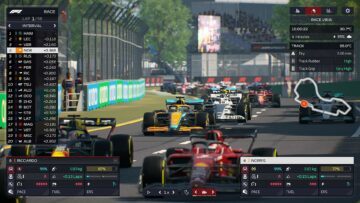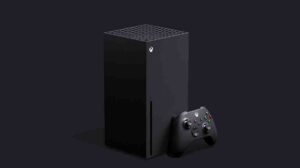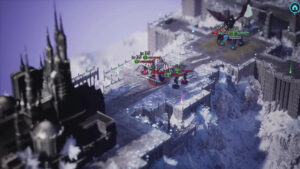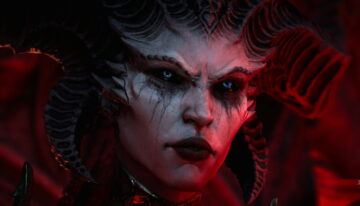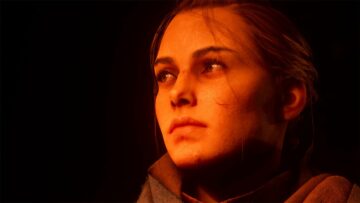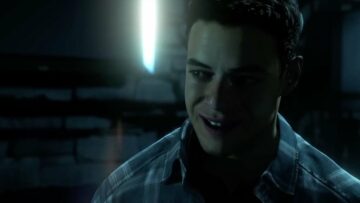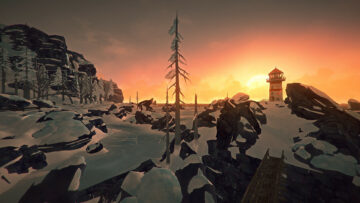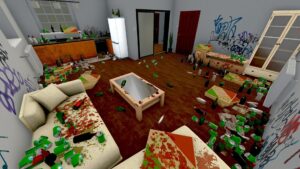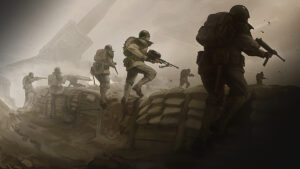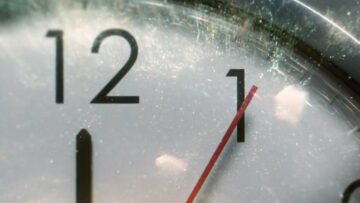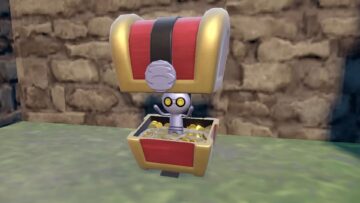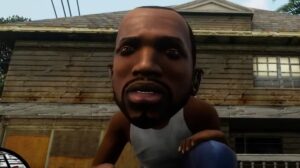Clash of Heroes really clicked for me when I stopped seeing the screen as a top-down view of the battlefield. This is somewhat counter-intuitive, because the screen is literally a top-down view of the battlefield, your troops on one side, your enemy’s on the other. But the game started to sing for me when I forgot all that and I started seeing this as the side-on view of a battle. A strange battle perhaps, but one which I could grasp quite cleanly on an emotional level. And that’s because now, my enemies weren’t in front of me but were instead above me. Much more frightening. Much more energising! I was at the bottom of the screen and all my enemy’s attacks were like daggers hanging overhead. And there’s a truth to this. Clash of Heroes is often a game about impending doom, about the terrible thing you know is coming your way. This is often a game about violence, suspended.
And it’s beautiful twice over. It’s beautiful because its richly colourful pixel-drawn heroes are beautiful, battlefield Muchas with billowing hair and perfect, heavily ornamented armour, moving through a series of moody fantasy worlds. And it’s beautiful because the rules that power everything you do in the game, to borrow a thought from Edwin, have the precise interconnected clarity you get from a poem. Puzzle-RPG is such an ugly term. This is a game with the lightness and steeliness of verse.
I’ve lost the last few days in the newish download version of what was once a DS classic. It’s now called Might & Magic: Clash of Heroes – Definitive Edition, a title that strains awkwardly against itself in exactly the same way that the game itself doesn’t. I would say I’ve been spellbound, but that has a little too much of the passive to it. I’ve been stirred by this game. Engaged. Terrified. Delighted. Sometimes furious.
That’s quite a cocktail. And a lot of it comes from those beautiful rules themselves, which vibrate strongly and elegantly even within the first campaign, which I’m still replaying. It’s simple, then it’s complex, and then it’s very complex, and in amidst the very complex stuff, you get glimpses – fleeting for me – that the game might ultimately have deeper, more central simplicities I could grasp if only my mind wasn’t so scrambled.
Ultimately, you and an army face each other across a divide, and you launch attacks at them by combining troops into columns of three identical units. Three green cloak guys? Ideal. Three blue bears? Perfect. Two green bears and one green cloak guy? Nope. Two green cloak guys and one yellow cloak guy? Get out of here.
In a way, the game plays a classic puzzle-game trick very early on. My personal theory is that every good puzzle game is built around what you can’t do but dearly want to, as much as what you actually can. And the reason you can’t do the thing you really want to do is because it would destroy the game. In Clash of Heroes, the thing that, time and again, I really want to do is jog a unit that I need across from one column into another. Not possible. It would make the game too quick, too forgiving, and too imprecise. You could do great things without meaning to, which is fun for a while but ultimately slightly infantilising. It’s a mark of the game’s greatness that I want to do this so regularly, though, and from the first battle onwards. It’s more than a wish. It’s a proper desire.
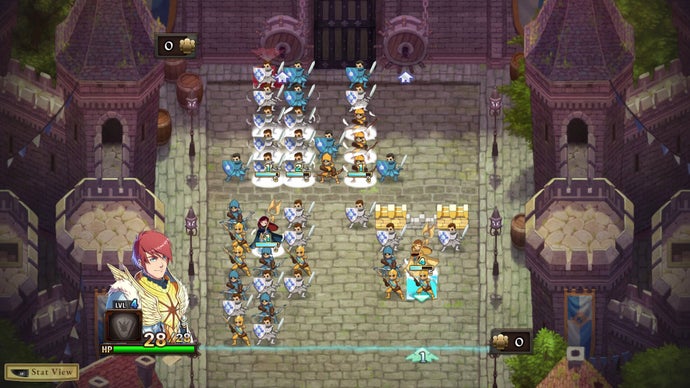
In terms of offensive strategies then, Clash of Heroes is a bit like the New York Subway. It’s great for going up and down, but most of the time if you want to go left and right you’re out of luck. (I’m now excited to note that when you can go left and right you get Times Square, certainly 42nd Street, if memory serves – yet another indicator that Clash of Heroes did the right thing not allowing you to in-jog from another column.)
But if you do line three identical units up in a row rather than a column, you get a wall, which acts as a layer of defence from attacks coming from above. There’s lots more to know – the game truly comes alive with chaining attacks, so they each get a boost, and fusing attacks, where you stack two groups of three identical units on top of each other and they become one super powered unit with the shorter of the two countdown timers. Oh god, I also need to mention countdown timers, which start ticking when a set of three identical units is created, but won’t allow the attack to actually fly up the screen towards your enemy until the timer hits zero. Yes. Absolutely. All of this is important and a huge part of the reason why this game is a classic. But we’ll get to that. And that’s because I first want to talk about walls.
Walls are great. Many of the classes in the game do different things with walls, and they also make you feel very virtuous when you take the time to build them. It’s the feeling you get when you put money into your pension each month instead of spending it on candy apples and moon pies, although I appreciate that anything regarding pensions sounds increasingly like science fiction. Anyway: thinking about defence as well as offence is just good business. It indicates a tidy head and a clear heart. But the more I’ve played the more I realise that deep down I think Clash of Heroes’ brilliance is how it manages to be scrupulously fair but unbelievably devious. It’s not a cheat, but it is a jerk, and all the better for that. And walls are a way into this understanding.
That’s because walls are actually a right pain. Your enemy’s walls are the stuff of nightmares, obviously, but even your own walls can be a real thorn. This is because you can trigger units into walls by mistake sometimes, which means that the offensive tool you’d been trying to construct has just disappeared into a defensive tool, which is virtuous, yes, but not particularly thrilling. More than that – and let’s bring in fusing – your own walls can take up space, and the space they take up can stop you from fusing units.
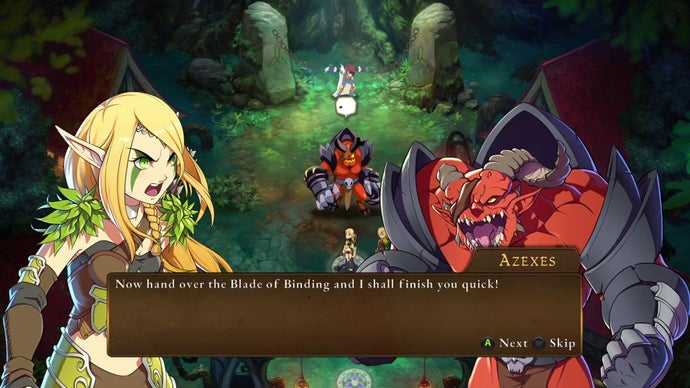
This in turn is because you need six gaps in a column to fuse units, and there are only six gaps, and a wall eats up at least one of them. God, what is this game trying to say? Is it trying to say that I should either focus on defence at the cost of my absolute best offensive move, or that I should go all in on offensive and leave myself wide open for retaliation?
Reader, for a long time I thought that was the decision that I was left with. But while Clash of Heroes is happy to be a jerk, it’s never a jerk for no reason. It’s trying to get you to stretch your mind a little and see how you can have both fuses and walls – it’s all just a matter of timing. Fighting in Clash of Heroes is a little like editing (we’ll come to this) and a little like cooking, and the part that makes it like cooking is that you need to think about the sequences of things. You need to wash the fruit before you slice it. If you have a wall already, you can actually kill it off yourself. So have a wall until you want to fuse, then kill the wall yourself, then fuse quickly, and if you can’t double-fuse, put a wall back in place after all. THIS is what Clash of Heroes wants you to do. This is the level it wants you to play at.
And it wants you to play at this level because, like many great games, Clash of Heroes is really about tempo. It’s not even a secret. All those countdown timers on your units and your enemies’ units dictate the pace of the game, and also point the way for people who really understand it at its core. This is a game where you can build something brilliant, but if you’ve built it at the wrong time – your timer’s too long and your opposing enemy’s unit’s timer is much shorter – it will be destroyed before you see it in action. You can put in a lot of work for no reward, which is a reminder that the game is a jerk. But the game is a jerk because you’re doing it all wrong. Don’t build for the sake of building. And, equally, and oppositely, don’t always think big. A small unit with a quick timer can finish off a weakened behemoth, and this is maddening for your rival because it means you’re sniping them through a gap in time as well as in space.
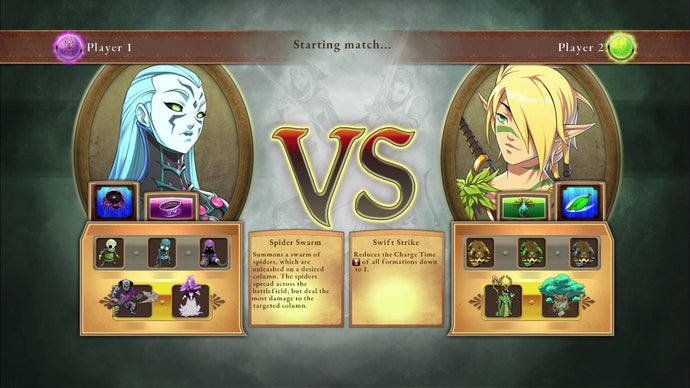
This big and small thing is another way that Clash of Heroes tries to trick you into making a mess in order to teach you how to avoid making a mess in the future. If this is a game of impending doom, it’s also a game of distractions – it’s tempting you to take your eye off the prize. The big units on the battlefield – big timers, take up more space, do massive, terrifying, game-changing damage – are there in part to make you forget the importance of the little units. Why wouldn’t you forget? These big units are completely rad!
But there is a danger in only going big. You can lose by neglecting a single part of your arsenal here – by being so focused on big units you let your smaller units wallow instead of using them for regular hits of damage. You can lose by being so focused on fusing you forget to attack in width. For a while I was so focused on each character’s super powerful spell I neglected pretty much all of the rest of the board – that was a bad idea too. People often talk about how ingenious Clash of Heroes is, how all of its pieces come together in this tight little knot of strategy. Yes. But people who leave tight little knots for you to untangle are mean, remember. Brilliant, frequently, but mean. To teach you, Clash of Heroes is always trying to lead you astray like a meanie, dangling the false promise of easy, flashy victories.
As a result, at the moment when I play, I tend to think of the big units as something that primarily exists on the other side – the enemy side. They’re there to focus my attacks and I shouldn’t bother with muddling with them myself. I need to get rid of my enemy’s biggies before they get rid of me. I need to get through them. I know that this is a sub-optimal way to play: it’s defensive and back-foot. But what can I say? It’s where I am at the moment, and with Clash of Heroes you’re never on one strategy for very long.
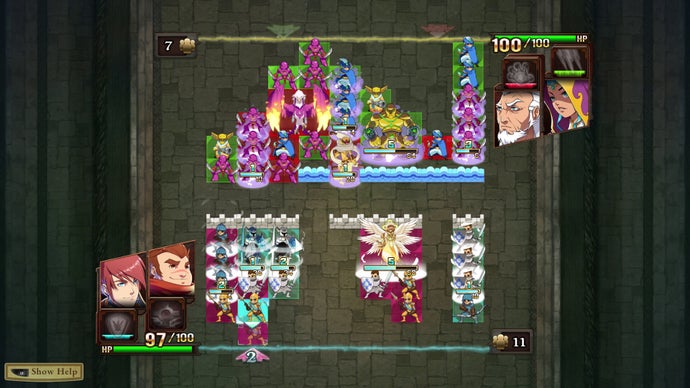
What I see as the way forward, though – and it’s another mark of the game that this too is always changing – is the editing side of Clash of Heroes. You can drag and drop units from one column to another, which is the traditional way of moving them about. But, yes, while you can’t in-jog them, you can select a unit in the middle of the column and remove it. Edit it. So a greeny between three yellows can be edited out giving you three yellows together, and also, because you made a match, giving you back the move you made in the edit.
I’ve been using this recently to set up combos of movements. One unit removed, and then this huge volumetric courtside wave of units and walls, offence and defence, clicks into place, sending my number of potential moves through the roof. I know this feeling! I get it by editing my own sentences, but I only get it very, very rarely. One word snipped out and a whole rush of new possibilities slides into place. It’s a once-a-year feeling for me in writing, if that, but in Clash of Heroes you can get it a little more often. That’s once the game has taught you, of course. And it teaches you by being a jerk.
God, there’s so much to say, but isn’t there always, when you’re dealing with a classic? There’s the different factions, their units and specials, that spider attack which always makes my skin tingle in horror but is also just incredibly useful. The gummy skeletons. The overworld with its neat nodes leading you forward on the adventure or off on a side-quest. I could talk for hours about the richness in this game in even the simplest of its elements.
But really I just want to get back out there – I want you to get back out there too. I want you to challenge Clash of Heroes’ inner jerk. I want you to experience all this doom, suspended.
- SEO Powered Content & PR Distribution. Get Amplified Today.
- PlatoData.Network Vertical Generative Ai. Empower Yourself. Access Here.
- PlatoAiStream. Web3 Intelligence. Knowledge Amplified. Access Here.
- PlatoESG. Automotive / EVs, Carbon, CleanTech, Energy, Environment, Solar, Waste Management. Access Here.
- PlatoHealth. Biotech and Clinical Trials Intelligence. Access Here.
- ChartPrime. Elevate your Trading Game with ChartPrime. Access Here.
- BlockOffsets. Modernizing Environmental Offset Ownership. Access Here.
- Source: https://www.eurogamer.net/might-magic-clash-of-heroes-is-still-the-most-elegant-and-instructive-meanie-in-all-of-games
- a
- About
- above
- Absolute
- absolutely
- across
- Action
- acts
- actually
- Adventure
- after
- again
- Against
- All
- allow
- Allowing
- already
- also
- Although
- always
- am
- amidst
- an
- and
- Another
- Anything
- appreciate
- ARE
- Army
- around
- Arsenal
- as
- At
- attacks
- avoid
- back
- bad
- Battle
- Battlefield
- BE
- Bears
- beautiful
- because
- become
- been
- before
- behemoth
- being
- BEST
- Better
- between
- BIG
- binding
- Bit
- Blade
- Blue
- board
- Boost
- borrow
- both
- bottom
- bring
- build
- Building
- built
- business
- but
- by
- called
- Campaign
- CAN
- candy
- central
- certainly
- challenge
- Champions
- changing
- character
- clarity
- classes
- Classic
- clear
- cocktail
- Column
- combining
- come
- comes
- coming
- completely
- complex
- Construct
- content
- cookie
- cookies
- cooking
- Core
- cost
- could
- countdown
- course
- created
- credit
- damage
- Danger
- days
- dealing
- decision
- deep
- deeper
- defence
- defensive
- delighted
- desire
- destroy
- destroyed
- dialogue
- dictate
- DID
- different
- do
- doesn
- doing
- don
- Doom
- down
- download
- Drop
- each
- Early
- easy
- editing
- edition
- either
- elements
- Emotional
- enable
- engaged
- equally
- Eurogamer
- even
- Every
- everything
- exactly
- excited
- experience
- eye
- Face
- fair
- false
- FANTASY
- feel
- few
- Fiction
- Fighting
- finish
- First
- Fly
- Focus
- focused
- For
- Forward
- frequently
- from
- front
- fun
- fusing
- future
- game
- Games
- Gaming
- gap
- gaps
- GDPR
- Get
- Giving
- go
- going
- good
- grasp
- great
- Green
- Hair
- hand
- happy
- Hard
- has
- Have
- head
- heart
- heavily
- here
- heroes
- hits
- Horror
- hours
- How
- How To
- HTTPS
- huge
- i
- idea
- ideal
- identical
- if
- impending
- importance
- important
- in
- increasingly
- incredibly
- indicator
- instead
- interconnected
- into
- Is
- isn
- IT
- ITS
- itself
- jpg
- just
- know
- last
- launch
- layer
- lead
- leading
- least
- leave
- left
- Level
- like
- Line
- listed
- Little
- ll
- Long
- lose
- lost
- lot
- Luck
- made
- Magic
- make
- MAKES
- Making
- manage
- many
- mark
- massive
- Match
- matter
- me
- mean
- meaning
- means
- memory
- Message
- Middle
- might
- mind
- moment
- money
- Month
- Moon
- more
- most
- move
- movements
- moving
- much
- my
- Neat
- need
- neglecting
- never
- New
- New York
- no
- nodes
- not
- now
- number
- Obviously
- of
- off
- offensive
- often
- oh
- on
- once
- One
- only
- open
- or
- order
- Other
- out
- over
- own
- pace
- Pain
- part
- particularly
- Passive
- pension
- pensions
- People
- perfect
- perhaps
- personal
- pieces
- place
- plato
- plato data intelligence
- platodata
- platogaming
- play
- played
- plays
- please
- Point
- possibilities
- possible
- potential
- power
- powered
- powerful
- precise
- pretty
- primarily
- promise
- proper
- put
- Puzzle
- puzzle game
- quick
- quickly
- quite
- rarely
- rather
- RE
- Reader
- Ready
- Real
- really
- reason
- recently
- Regarding
- regular
- regularly
- Remember
- remove
- removed
- REST
- result
- reward
- right
- Rival
- roof
- rules
- rush
- s
- same
- say
- Science
- science fiction
- Screen
- Secret
- see
- seeing
- Series
- serves
- set
- settings
- should
- side
- Simple
- single
- SIX
- Skin
- small
- smaller
- So
- something
- Space
- special
- specials
- Spending
- square
- stack
- stacked
- start
- started
- still
- stop
- Strains
- Strategies
- Strategy
- street
- strongly
- such
- super
- suspended
- Take
- talk
- targeting
- taught
- Tempo
- term
- terms
- than
- that
- The
- The Future
- The Game
- their
- Them
- themselves
- then
- theory
- there
- These
- they
- thing
- things
- think
- Thinking
- this
- Thorn
- those
- though
- thought
- three
- thrilling
- Through
- ticking
- time
- times
- Times Square
- timing
- Title
- to
- together
- too
- tool
- top
- towards
- traditional
- trailer
- trigger
- true
- truly
- truth
- turn
- Twice
- two
- ultimately
- Understand
- understanding
- unit
- until
- up
- using
- ve
- version
- very
- victories
- View
- Wall
- want
- wants
- was
- wasn
- Wave
- way
- we
- well
- were
- weren
- What
- What is
- when
- where
- while
- WHO
- whole
- why
- wide
- will
- window
- winning
- with
- within
- without
- Work
- Worlds
- would
- wouldn
- writing
- wrong
- yes
- yet
- york
- you
- your
- yourself
- youtube
- zephyrnet
- zero
